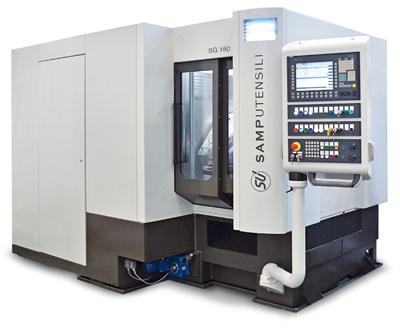
Samputensili offers a ground-breaking concept that totally eliminates the need for cutting oils during the grinding of gears after heat treatment. The new machine, which is called SG 160 SKY GRIND, features two spindles: one for skive hobbing and one for generating grinding.
When grinding, most of the heat is transferred into the workpiece. Reducing friction, discharging the heat and evacuating the chips are the primary technological tasks for the oil-based lubricant. However, the equipment dedicated to the oil treatment:
- absorbs 75 percent of the total energy consumed by a grinding machine,
- requires a massive amount of space, and
- significantly contributes to the costs of investment and maintenance of grinding machines.
Enrico Landi, Division Director of Samputensili Machine Tools, explained: “The new SG 160 SKY GRIND removes 90 percent of the stock allowance with the first pass using a skive hobbing tool, which has the advantage of not heating the workpiece excessively. Subsequently, with the second finishing pass, a grinding wheel removes the remaining stock without causing problems of overheating the workpiece, therefore resulting in a completely dry process."
Moreover, its innovative structure with two spindles actuated by linear motors and the use of more channels simultaneously ensure a chip-to-chip time of less than 2 seconds.
The result, according to the company, is a productive machine that's even faster than traditional dual-table grinding machines. More importantly, the company noted, eliminating the need for cutting oils makes the machine environmentally friendly, both toward ecosystems and the health of working people.
Contact Details
Related Glossary Terms
- grinding
grinding
Machining operation in which material is removed from the workpiece by a powered abrasive wheel, stone, belt, paste, sheet, compound, slurry, etc. Takes various forms: surface grinding (creates flat and/or squared surfaces); cylindrical grinding (for external cylindrical and tapered shapes, fillets, undercuts, etc.); centerless grinding; chamfering; thread and form grinding; tool and cutter grinding; offhand grinding; lapping and polishing (grinding with extremely fine grits to create ultrasmooth surfaces); honing; and disc grinding.
- grinding machine
grinding machine
Powers a grinding wheel or other abrasive tool for the purpose of removing metal and finishing workpieces to close tolerances. Provides smooth, square, parallel and accurate workpiece surfaces. When ultrasmooth surfaces and finishes on the order of microns are required, lapping and honing machines (precision grinders that run abrasives with extremely fine, uniform grits) are used. In its “finishing” role, the grinder is perhaps the most widely used machine tool. Various styles are available: bench and pedestal grinders for sharpening lathe bits and drills; surface grinders for producing square, parallel, smooth and accurate parts; cylindrical and centerless grinders; center-hole grinders; form grinders; facemill and endmill grinders; gear-cutting grinders; jig grinders; abrasive belt (backstand, swing-frame, belt-roll) grinders; tool and cutter grinders for sharpening and resharpening cutting tools; carbide grinders; hand-held die grinders; and abrasive cutoff saws.
- grinding wheel
grinding wheel
Wheel formed from abrasive material mixed in a suitable matrix. Takes a variety of shapes but falls into two basic categories: one that cuts on its periphery, as in reciprocating grinding, and one that cuts on its side or face, as in tool and cutter grinding.

